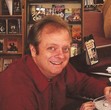James Rada Jr.'s Blog, page 16
July 19, 2016
Civil War Echoes: Mrs. Longstreet and the B-29
This is interesting. A Confederate general’s widow who helped build B-29s.
Of all American weapons produced in World War II, including the atomic bomb, the most expensive was the Boeing B-29 Superfortress. Developing and producing the plane cost $3 billion and involved a massive industrial undertaking from plants in all regions of the country. The plane made key contributions to victory in the Pacific and in the prosecution of the Korean War before being retired in the 1950s. 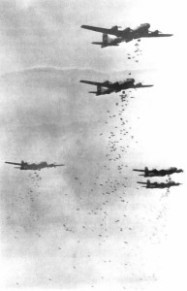
Thousands of subcontractors made components and systems for the plane, which was the most advanced of its day. The B-29s themselves were assembled at four main plants: Boeing facilities in Renton, Washington and Wichita, Kansas; a Martin plant in Omaha; and a Bell plant in Marietta, Georgia. It is this last plant that offers an echo of the Civil War and a symbol of national reconciliation.
View original post 322 more words


July 14, 2016
Get Looking Back: True Stories of Mountain Maryland FREE!
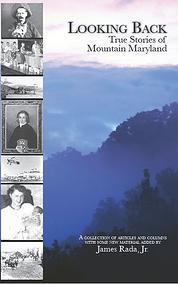 Today is the last day to get the Amazon.com bestselling book Looking Back: True Stories of Mountain Maryland as a FREE Kindle e-book.
Today is the last day to get the Amazon.com bestselling book Looking Back: True Stories of Mountain Maryland as a FREE Kindle e-book.
The book is filled with true stories about Western Maryland that will keep you reading whether you’re a native of Western Maryland or just someone who has heard about it.
Did you know that a Russian prince once worked as a priest in Cumberland?
Have you heard the story about the German POW camp near Flintstone during WWII?
Do you know about the mining wars that were fought to try and unionize the coal mines in the Georges Creek region?
Do you know the story behind Cumberland’s only lynching? Have you heard the story about the baseball game played between the Cumberland Colts and the New York Yankees?
These are the stories of Allegany and Garrett counties in Maryland found in old newspapers, history books and other places. It’s the stories of people who tamed the mountains, established cities, raised families and lived their lives.
Journey back in time and look beyond the photos that so well document the region’s history. This collection of 40 stories spans 220 years of life in Western Maryland.
Looking Back hit no. 1 in Amazon’s Mid-Atlantic E-book category yesterday (I took a screenshot to mark the occasion) and has since climbed into the top 500 of non-fiction e-books. 
Grab your free copy today and let me know what you think by leaving a review. That will help my future marketing efforts for the book.
Here are some of the types of stories that you’ll find in Looking Back: True Stories of Mountain Maryland:
Train crashes into county school bus killing seven children
Labor trouble on the C&O Canal
How did the young lovers die on the eve of their wedding? (part 1)


July 6, 2016
How To Write a Novel (When You Think You’ve Forgotten How)
Here’s some useful information. I’ve been in this situation before and it is scary. It’s like forgetting how to ride a bike.
As regular readers of this blog will know, I am a pathological procrastinator. I don’t know why, but I do know that I have never been able to delay gratification. So instead of rewarding myself with 7 hours of OJ: Made in America when the first draft of Book 2 is done and dusted and I can relax and enjoy it guilt-free, I watch it now and tell myself I will write after. I mean, I’d just be distracted by my wanting to watch it otherwise, right?
(Side note: OJ: Made in America is truly incredible TV.)
I joke that I’d call my would be productivity guide Don’t Start Until It’s Already Too Late – and that’s pretty much what I do. I can only work under pressure, while panicking. I read somewhere that the procrastinator’s sweet spot is the exact moment when the fear of creating something crap is…
View original post 1,931 more words


July 5, 2016
Winfield Scott Reconsidered
An informative post. Give it a read.
On this day in 1841, precisely 175 years ago, Major General Winfield Scott became Commanding General of the U.S. Army. He held this post for 20 years and four months, longer than any other Commanding General or U.S. Army Chief of Staff to date, retiring as a Brevet Lieutenant General on November 1, 1861.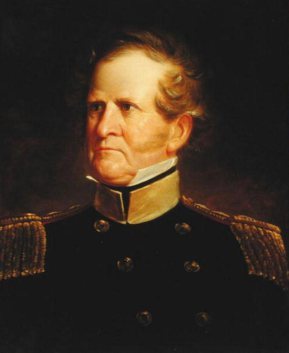
To Civil War audiences, Scott is something of a comical figure: a fat old man who can’t mount his horse, not to mention an object of derision by George McClellan and younger officers. His nickname “Old Fuss and Feathers” seems to imply a dodding old man more interested in pomp than in crushing the Confederacy.
This perspective is grossly unfair to Scott, who in fact was one of the great soldiers of the 19th Century and also played an important,if sometimes hidden, role in the Civil War.
View original post 405 more words


June 30, 2016
Start your engines!
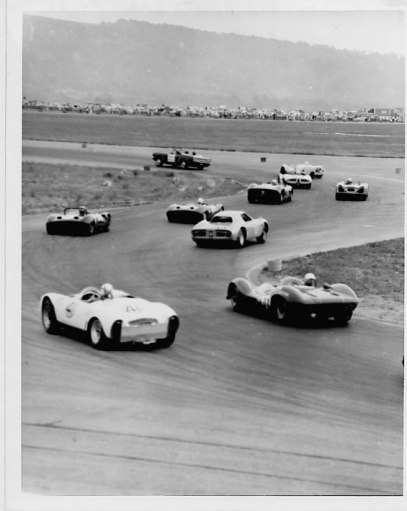
Courtesy “National Road” Autosports, http://www.nationalroadrally.com
The Cumberland Municipal Airport has never been busier than when sports cars raced around its runways.
Yes, sports cars. Not airplanes.
Each May from 1953 to 1971 racers from across the country would travel to Cumberland to test their sports cars against other top cars to see whose was the fastest. Roger Penske, Shelby Briggs and Carroll Shelby all raced at the Cumberland Airport. The races featured some of the greatest racing cars of the time: Birdcage Maserati, Ferrari Testa Rossa, D Type Jaguar, Porsche 356 Speedster, Cobra, Mustang, Camaro, Sunbeam Alpine, Austin Healy 100, and the Howmet Turbine Car.
“It was a great time,” said Dave Williams. “A who’s who of American sports car racing came through Cumberland.” Williams watched many of those old races as a young man and he remains a racing enthusiast and promoter of sports car racing today.
The Cumberland Municipal Airport offered a 1.6-mile-long course for the racers. In the days before permanent automobile racetracks became common, airport runways offered a satisfactory alternative.
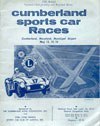
Courtesy “National Road” Autosports, http://www.nationalroadrally.com
Cumberland Lions Club staged the annual races and their proceeds helped provide free eye exams and glasses for needy children in the county, helped build Lions Manor Nursing Home, contributed to the Wilmer Eye Clinic at Johns Hopkins and provided funding to the local Salvation Army, Boy Scouts of America, and YMCA.
May 1953 saw the first races at the airport. It was a result of months of planning between officials from the airport, Cumberland Lions, and Pittsburgh Steel Cities Region – Sports Car Club of America.
“The initial 1953 event started as Steel Cities/Pittsburgh Regional Races with 80 entries and a rather sparse group of spectators,” Bob Poling and Bill Armstrong wrote in Wings over Cumberland: An Aviation History.
Word spread locally and through the racing community that the airport in Cumberland was a great track on which to race.
The following year 122 racers and their cars showed up to compete before a crowd of around 12,000 people. This led to Cumberland’s regional event becoming a national one.
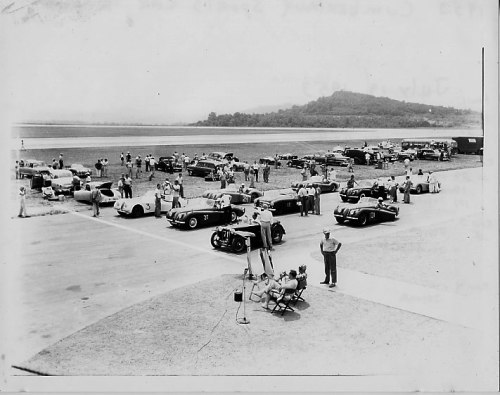
Courtesy “National Road” Autosports, http://www.nationalroadrally.com
“Being a national event meant that it was the most-important event in your region in a year,” said Williams.
It also meant that only racers with a national competition license could compete at Cumberland. There were only 1,100 nationally licensed drivers in the country at that time and 284 of them showed up in Cumberland to race in 1955. They came from 40 of the 48 states, Washington, D.C. and Canada. The racers competed in 11 races from 8:30 a.m. until 4:15 p.m. giving racing fans a full days of thrills.
As a national event, Cumberland began getting featured in media across the country. Sports Illustrated listed the Cumberland Airport Races among the big coming events in the world of sports.
“It represented the largest car race conducted in the US and included many prominent racing figures such as the Briggs Cunningham team of Maseratti race cars. Also, the American manufactured Corvette was making its presence known,” wrote Poling and Armstrong.
The Cumberland Sports Car races continued to grow in popularity with fans. Some of the highlights over the years include:
1956 – Band leaders Paul Whiteman and Skitch Henderson along with actor Steve Allen race in Cumberland.
1957 – Famed racer Carroll Shelby wins the main event at Cumberland.
1958 – Roger Penske taking his SCCA driver’s test in Cumberland in a 283 Corvette. Penske got his license at the cost of his car. He blew the engine and then it fell off the trailer as he took it home.
1965 – The new GT Mustang driven by Bob Johnson wins the Production Car race.
1966 – The Walt Hansgen Memorial Trophy is awarded in memory of a five-time winner at Cumberland. Hansgen was killed in a crash at LeMans earlier in the year.
1967 – What would become a classic—the Z28 Camaro—won its first race.
1968 – Ray Heppenstal drove the turbine-powered Howmet TX Turbo car. Billed as the “car of the future”, it lost its race to Bob Nagel’s McKee Ford 427.
The peak year for the races, as far as attendance goes was 45,000 people in 1958. This was also the year a racer went over the embankment at the airport. Louis Jeffries was driving a Siata Special when the brakes failed coming off a long straightaway. The car went over the embankment, rolling several times until it reached the bottom. Jeffries was injured but not seriously. It was the only time that this type of accident happened during the races.
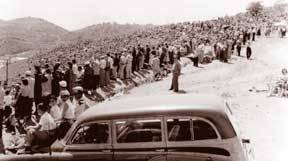
Courtesy “National Road” Autosports, http://www.nationalroadrally.com
“By the early 1960’s, though, airport courses were being replaced by permanent sports tracks and attendance at airport races declined,” said Williams.
Though the community supported the races, some people were starting to complain about the ground at the airport being torn up and that the cars racing at Cumberland were starting to show their age.
Then the Cumberland Mayor and City Council voted to ban car races at the airport after June of 1971. This allowed the 1971 race to go on. Only 200 cars entered the races and competed against each other before 12,000 fans. Almost as if to mark the sadness of the last airport races in Cumberland, it rained through much of the day.
The Federal Aviation Administration agreed with the actions of the city government. In a letter to the city, an FAA official wrote that “it is evident that increased use of the airport requires that all facilities be available for aviation purposes.”
Amateur racing had been struggling in recent years not only because access to airports was being denied organizers, but insurance costs for such events were rising dramatically. Also, many of the big-name draws for these events had turned professional, taking much of the fan base with them.
Allegany County continues to have autocrosses but nothing like the head-to-head competition that once thrilled residents.
For more information:
Here’s are some links to more information about Cumberland auto racing.
Racing Sports Cars
Cumberland Airport Autocross Facebook Page
“National Road” Autosports


June 23, 2016
The Death of Warren Harding
With the possible exception of John F. Kennedy, no president’s death generated more speculation and controversies than that of Warren G. Harding. The President Dies On August 2, 1923, the country …
Source: The Death of Warren Harding


Train crashes into county school bus killing seven children
Having no children of his own, 49-year-old Leroy Campbell enjoyed the laughter and squeals of the children he drove to and from school each day, but it was their screams of terror that would haunt him for the rest of his life.
Campbell had a perfect driving record and he had driven a school bus for the Garrett County Board of Education for eight years by 1959. He picked up children in the Loch Lynn and Mountain Lake Park areas and delivered them to Southern High School and Dennett Road Elementary every day school was in session.
On the morning of September 10, 1959, Campbell had picked up 27 students and was heading towards the schools where he would drop them off. As he was crossing the railroad tracks at Route 560 in Loch Lynn, the bus stalled.
He was attempting to restart the engine when the bells crossing lights started flashing and the bells started ringing. Campbell looked up and saw the eastbound Diplomat passenger train from St. Louis fast approaching on its way to Washington.
Roy Dixon, a 12-year-old student on the bus, said later, “I’ll never forget the look on Mr. Campbell’s face. He looked like he was scared to death. But he’s a good driver and he helped to get some of the kids off the bus.”
Campbell ordered the children off the bus through the front door. Campbell said the rear exit was not opened because it would have let the children out right on the railroad tracks.
“Everybody knew the train was going to hit us. Everybody wanted to get out. Everybody rushed to the doors of the bus all at one. One girl, she got stuck in the door. I didn’t know what to do. Finally, somebody pushed her out,” Roy said. His story is part of a display about the accident at the Garrett County Museum of Transportation.
Delores Shaffer was the girl pinned in the door until someone pulled her free. She and eight other children managed to get off the bus.
Engineer Otto Droege saw the bus and thought it would cross over the tracks. When he realized it was stalled, he applied the emergency brakes of the train. The train lurched and the brakes squealed.
Roy said, “I grabbed [my younger sister, Gladys] by the hand and we jumped. I ran down the track and saw fire flying from the wheels of the engine. Then I looked back and saw the train hit. There was a big cloud of dust, then kids came flying out through the windows.”
The train quickly slowed from 50 mph (the legal limit), but it was still going 20 mph when it hit the bus and pushed it down the track until it wrapped around a utility pole.
“The train hit and it jerked me,” Mary Ellen Itnyre, a 14-year-old student on the bus said later. “I was knocked under the front seat. There was a lot of dust and it was dark and I thought the train was carrying me away with it. All I could hear after the crash was the moaning and groaning from the rest of the kids in the school bus.”
Phyllis Paugh, lived in an apartment next to crash scene. When she heard the crash, she ran outside to see what had happened. “When I got outside, I got a little weak. There were children screaming…some had blood on them…they were crying, and there was a lot of confusion. The children’s bodies were scattered along the track. Some were hurt, but some of them looked dead. They were lying along the tracks from the crossing where the train hit, down to where the bus had stopped,” Paugh said.
Seven ambulances and two station wagons quickly responded to the scene. Some of the vehicles couldn’t speed while transporting the children to the hospital because they were so seriously injured that they needed to be given blood transfusions while en route, according to the Cumberland Evening Times. Injured children were taken to Garrett Memorial Hospital, but the available beds there were quickly filled. Children were also sent to Sacred Heart Hospital in Cumberland and Preston Memorial in Kingwood.
Roy was scared, not only about what had happened to the bus, but he couldn’t find his older sister, Frances. He feared that she was dead, but he later saw her at Garrett Memorial being unloaded from an ambulance.
Roy, Frances, and Gladys were lucky. Seven children weren’t so lucky. Janet Deem, 12; Nancy Deem, 15; Merle Harvey, 11; Nancy Harvey, 12; Richard Hinkle, 11; Lee Hoffman, 11; Shirley Lee, 12, all died in the accident.
Frances Dixon was among the 11 children who were seriously injured. She had a broken back, a broken collar bone, a broken cheek bone, and a torn Achilles tendon. She spent the next four months in a body cast, but she survived.
You can learn more about the accident from the display at the Garrett County Transportation Museum.
More Garrett County, MD, stories:
The champion coal miner of the world
LOOKING BACK 1953: CIA doses men with LSD at Deep Creek Lake (Part 1)
LOOKING BACK 1953: CIA doses men with LSD at Deep Creek Lake (Part 2)
LOOKING BACK 1917: Bank robbers get away with a haul from small town bank


June 16, 2016
The mystery of the Masons and their history in Thurmont
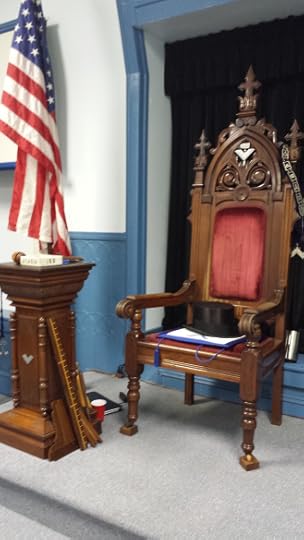
The chair where the Acacia Lodge Grandmaster sits during lodge meetings.
Freemasonry conjures up images of a secret society with hidden rituals and, thanks to the movie National Treasure, hidden treasure. Yet, the Masons are far from secret. They are men who work hard to find brotherhood, enlightenment, and truth.
When John Hagemann first came to Thurmont in 2006 and joined the Acacia Lodge No. 155 of the Ancient Free and Accepted Masons, another Mason pointed to a long row of 8×10 photographs hung on the wall of the Masons’ lodge social hall. They were the Worshipful Masters (lodge presidents) of the Acacia Lodge, and Hagemann recognized many of the last names as members of long-time Thurmont families.
“I was told that if I worked hard, one day my picture could be up there, and it is,” Hagemann said.
He is the current Worshipful Master of the Acacia Lodge.
The Masons came to Maryland in 1750, not in Baltimore, which was the largest population center at the time, but in Leonardtown. They weren’t established in what is now Frederick County until just before the Revolutionary War. Not much is known of the early lodges in the county. The largest lodge was called Hiram Lodge, and there was a lodge that served the army during the War of Independence. Those two lodges, along with other small lodges, combined to form the Columbia Lodge in 1815.
“The Masons met in a home at the corner of Market and Second Street,” said Kenneth Wyvill, Grand Master of the Maryland Masons.
This combined lodge was enough to meet the needs of the county Masons for 66 years.
“As population centers grew and shifted, Masons would decide to form new lodges,” said Wyvill.
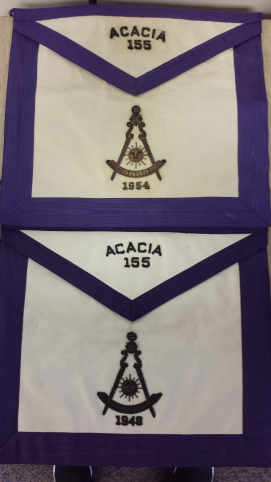
Historic aprons once used by Thurmont’s Masons.
The first lodge to break off from the Columbia Lodge in Frederick was Acacia Lodge No. 155 of Mechanicstown. In all, six new lodges formed in Frederick County between 1871 and 1906.
Thirteen Masons in the area formed the lodge in Mechanicstown with Robert Lyon as the first Worshipful Master (lodge president). The new lodge’s first meeting was held on May 22, 1871, in a room on the third floor of the John Rouzer apartment house opposite the Lutheran Church on Church Street. Besides choosing officers, it was decided to name the lodge the Acacia Lodge.
Not all of the charter members of the Acacia Lodge came from the Columbia Lodge. Others came from lodges in Baltimore, Westminster, and Union Bridge.
Even before the Acacia Lodge received its charter and was officially recognized, it had begun to grow as two new members were added.
The Acacia Lodge was examined by other Maryland Masons in October 1871 to see if its membership was proficient enough to support their own lodge and on November 21, 1871, the Acacia Lodge was granted its charter.
“They first rented the International Order of Odd Fellows hall to meet in,” Hagemann said.
The Acacia Lodge continued to grow between 1872 and 1876, but for the next two years, many of the members found themselves working away from Mechanicstown.
“Membership dwindled and the Maryland Grand Lodge actually took back our charter, but the members still continued to pay dues,” Hagemann said.
The charter was revoked in 1879, but the local Masons still paid dues and worked to establish stability to their lodge. They applied for restoration of their charter in 1887 and it was granted on December 19.
One of the things that the members decided would help their stability was to own their building rather than continue to rent space. Beginning in 1894, the Masons under Worshipful Master Leonard Waesche began looking into buying the Bussard Building (where the lodge is currently located at 12 E. Main Street) and adding a third floor to it.
“The lodge bought the building in 1898 and added the third floor to it for our lodge hall,” Hagemann said.
The Masons also made repairs to the first and second floors of the building and began renting out the space. Over the years, the first two floors have been a livery, doctor’s office, post office, grocery store, drug store, beauty parlor, and more.
When the lodge celebrated its first 50 years at the Thurmont Town Hall on November 29, 1921, only three of the original members were still living. They were George Stocksdale, Leonard Waesche, and David Martin.
World War II saw a surge in attendance at lodge meetings, mainly because of servicemen stationed at nearby Camp Ritchie who came to the Acacia Lodge. The Acacia Lodge conferred Masonic degrees on servicemen on behalf of other lodges through the Masonic Service Association.
“At the end of World War II, we had 156 members, which is the largest we’ve ever been,” Hagemann said. Of that number, 84 were veterans.
In 1959, the U.S. Post Office moved out of the first floor of the lodge building and into a stand-alone building that the Masons had built. However, a new tenant was found to fill the vacant first floor of the lodge building.
The last tenant for the second floor of the lodge left in 1960. The space remained vacant until 1962 when it was decided to use the floor as the lodge’s social hall and it continues to be used for that purpose today.
Though generally believed to be a Christian group, Masons include many faiths. Each lodge has a book of faith on its central altar. The Acacia Lodge uses a Bible, but other lodges can include a book of faith for the predominant religion of the lodge.
“It doesn’t matter what religion you are, you just have to believe in a higher power,” Hagemann said
The Acacia Lodge currently has 77 members, although Hagemann notes that like many civic and volunteer organizations, the average age among members seems to be rising as fewer young people become involved with organizations. The Acacia Lodge is one of 102 Maryland lodges and 15,000 Masons.
The Acacia Lodge is involved in many civic activities and participates in parades and building dedications. They can be identified in full regalia that includes tuxedos, top hats, and aprons. The local Masons dedicated the cornerstone of the Thurmont Library and have contributed money to many local efforts, such as purchasing a new flag pole for the town and paying for the memorial stone for servicemen in Memorial Park.
“We also have an annual scholarship that we award for $1,000 a year for a senior in the Catoctin High district,” Hagemann said.
Hundreds of Maryland Masons will be participating in a parade in Baltimore in full regalia for the re-dedication of the Washington Monument on July 4. The Masons laid the cornerstone for the original monument in 1815 and re-laid the stone in 1915.
“We’ll be using the implements from the time period of 1915 to rededicate the cornerstone,” Wyvill said.
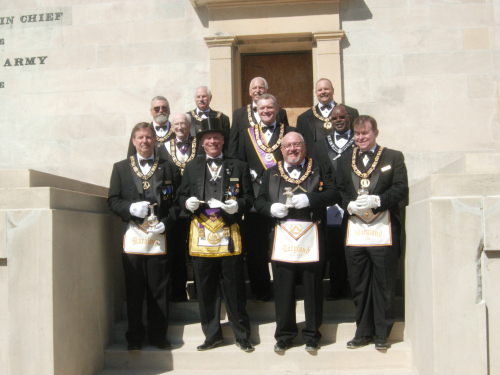
Masons at the rededication of the Washington Monument in Baltimore.


June 9, 2016
Prince Georges County in the War of 1812
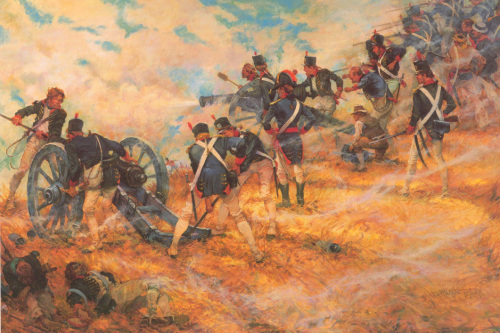
Col. Charles Waterhouse’s painting of the Battle of Bladensburg shows U.S. Marines manning their guns during the battle.
A generation after America won her independence from Great Britain, the young country declared war once again on Great Britain, though enough veterans from both sides were still alive to remind the younger politicians of the toll the first war had taken.
In 1812, neither the U.S. nor the British were prepared to fight again. Had trans-Atlantic communications been faster, it was a war that might not have even happened.
The British fought a defensive war in the early years of the War of 1812 because they were also fighting against Napoleon Bonaparte and the French army and navy. By 1814, Napoleon had been defeated and the British turned their attention more fully to ending the war with the United States with a victory. Up to this point, most of the fighting had been around the Canadian and U.S. border to the north. In the Mid-Atlantic, the British had started a blockade in 1813.
When the British did come ashore, they met with little resistance so they were confident they could bring the United States to its knees.
Landing in Prince George’s County
On June 15, 1814, Capt. John Richard Lumley led his frigate, Narcissus, and 12 other boats up the Patuxent River to land 180 British marines at Benedict, a small port town in Prince George’s County. “Here the men disembarked, and drove into the woods, without a struggle, a number of militia, who left behind a part of their muskets and camp equipage, as well as a 6-pounder field piece. After spiking the latter, and destroying a store containing tobacco, the British again took to their boats, except five or six men, who had probably strayed too far into the woods,” William Marine wrote in The British Invasion of Maryland 1812-1815.
This lack of resistance was typical of what the British faced against untrained and untested militia. The farmers and merchants who generally composed militias tended to melt away when facing disciplined and battle-tested veterans of the Napoleonic Wars.
From Benedict, the British sailed further up the Patuxent River and landed at the port town of Lower Marlborough. They captured a merchant ship loaded with tobacco and burned warehouses holding 2,800 hogsheads of tobacco at both Lower Marlborough and Magruder, which was just across the river.
On August 20, the British landed again at Benedict, but this time, 4,500 British marines went ashore and began a march toward Washington.
Though the British knew where they were going, area residents were still unsure as to whether the army’s destination was Annapolis, Baltimore or Washington, according to Ed Day, Museum Director Riversdale House Museum. Acknowledging that the British weren’t taking the most-efficient route to Washington, he said, “It was part of the ‘fog of war.’ They didn’t want to let the Americans know definitely where they were going so they could prepare a defense.”
Along the way, the British passed through Upper Marlborough. It was mostly deserted. Residents had fled when they heard about the approaching British troops. However, Dr. William Beanes was still there. He would play a role in the creation of the National Anthem, but at this time, he only wanted peace.
“Dr. Beanes actually offered the British lodging and food when they came through,” said Aaron Marcavitch, Executive Director of the Anacostia Trails Heritage Area.
The British took him up on his hospitality and spent the night before moving on the next day.
Joshua Barney and his Flotilla
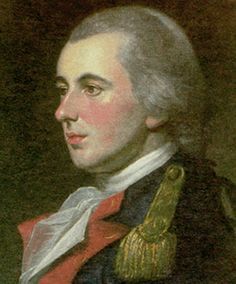
Joshua Barney
Joshua Barney was a Maryland native who first went to sea when he was 16 years old. During the Revolutionary War he quickly rose through the ranks to become a commodore.
As the British blockade along the Atlantic seaboard became more effective at shutting down trade, the Secretary of the Navy offered Commodore Barney a flotilla of gunboats to protect the Chesapeake Bay. Though the command was independent of the navy, Barney would receive his orders from Washington. Barney accepted and his 26 boats and 900 men were ready for operations in April 1814.
However, when his flotilla chased down some British ships on June 1, the British got reinforcements from larger ships that forced the flotilla to retreat up the Patuxent. They remained there during the summer, engaging the British when they could and occasionally going ashore to set up gun batteries to pound the British ships.
When Barney heard that the British had landed at Benedict in August, he took 400 of his men to intercept them before they reached Washington. He left the remainder of his flotilla near Pig Point under the command of Lt. Frazier with orders to scuttle the ships should the enemy approach in force.
Battle of Bladensburg
As the British approached Bladensburg, the local militia scrambled to prepare a defense without adequate equipment. “Francis Scott Key was out there on the field of battle directing troops,” Marcavitch said.
Two lines of defense were formed about a half mile apart.
The British entered Bladensburg and were greeted by gunfire from the first line. The British fell back and took cover behind the buildings in the town. Safe from gunfire, the British began launching Congreve rockets, which would become famous in the coming days for their “red glare.”
The rockets bursting overhead caused confusion on the front line. The leaders were uncertain about their support from the second line and ordered retreat along what is now Bunker Hill Road.
“President Madison was on the field at Bladensburg,” Day said. “It is the only time that happened with a president at a battle.” The reason quickly became obvious. Madison and his cabinet were with the second line of defense, which is roughly where 40th Avenue is now. They came out to watch the battle’s progress, but the second line of defense quickly folded as the men saw the first line militiamen retreating. The President and his cabinet barely got away. As the retreat turned into a rout, cannons were left behind.
Amid this confusion, Barney arrived with his men and set up cannons atop a hill where Eastern Avenue is now. The navy men began firing on the British who were near Dueling Creek.
“They inflicted some serious damage on the British, but eventually they were outflanked and Barney was wounded,” Marcavitch said.
Because of Barney’s assistance, the Americans had delayed the British for about five hours. That delay turned out to be long enough for Dolly Madison to save some of the national treasures in the President’s Mansion.
“When the British captured him, they actually told Barney, ‘Thanks for giving us some fight.’ They treated his wounds and pardoned him immediately,” Marcavitch said.
Burning of Washington
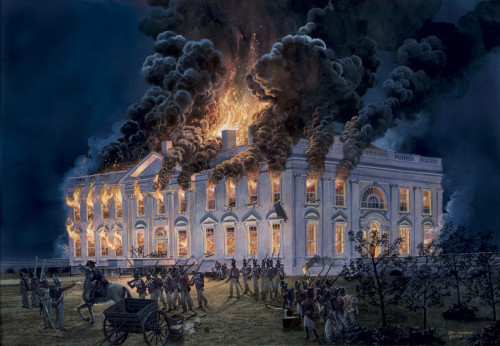
The British burn the White House in 1814.
The British left Bladensburg at 4 p.m. and by that evening the U.S. Capitol, the President’s Mansion and other buildings were in flames. The destruction continued into the next day.
“It took a lot of nerve to do what they did and later, they denied that they went to Washington to burn it,” Day said.
It was only a hurricane-force storm that stopped the destruction and convinced to British to leave the city and head back to their ships. The storm and hot, humid temperatures that the soldiers had experienced prior to that had made them miserable in their wool uniforms. Add to that the fact that they were tired from the marching and fighting that they had been doing. Men were so worn out that they died on the four-day march back. Many of the sick and wounded were left at the Stoddard House in Bladensburg where they received care.
“As they marched through Bladensburg to Upper Marlboro, some of the stragglers began causing problems so Beanes and a few others arrested the troublesome soldiers. When the British commanders learned about this, they sent soldiers back to arrest Beanes,” Marcavitch said.
It fell upon Key to travel to Baltimore to negotiate for Beanes’ release. And it was there aboard a British ship that Key watched the bombardment of Fort McHenry, which became the inspiration for “The Star-Spangled Banner.”
The War in Hindsight
Though the Marylanders did not stop the British from burning Washington, their service and the war does have meaning.
“Without Prince George’s County, you have no National Anthem,” Marcavitch said.
Day said, “It made Americans wake up to the fact that they needed a stronger standing army.”
He added that he believes a fitting commemoration of the war would be to have modern-day American and British marines shaking hands at the location where Barney’s men delayed the British march on Washington.
“Since then, they’ve had our backs and we’ve had their backs,” he said. “The War of 1812 was just a family squabble.”


June 3, 2016
The Future of Civil War History: Jim Broomall (part one)
Interesting read. Take a look.

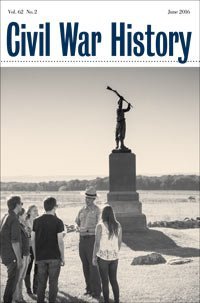 part one of a four-part interview
part one of a four-part interview
What’s the future of Civil War history? That’s the question very much on the mind of Dr. James Broomall these days.
Broomall—or “Jim,” as we call him around here at ECW—is the director of the George Tyler Moore Center for the Study of the Civil War (GTMC) and an assistant professor of history at Shepherd University. He’s also a member of ECW’s “Engaging the Civil War” series with Southern Illinois University Press.
Jim recently co-edited a special issue of the journal Civil War History that addressed the topic of the future of Civil War history. The journal sprang from a conference hosted in March of 2013 by Gettysburg College and co-sponsored by the Gettysburg Foundation and Gettysburg National Military Park.
Over the next few days, I’ll share a conversation I had with Jim about the journal, the conference it sprang from, and…
View original post 898 more words






